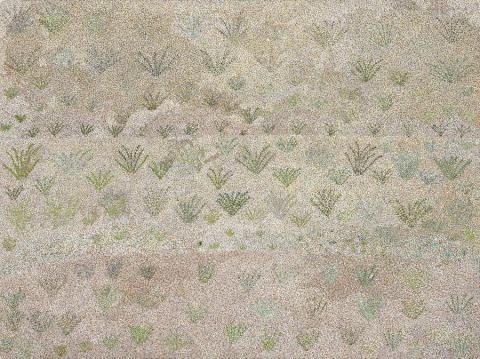ARRETH, 2003
LILY MORTON AKEMARR
synthetic polymer paint on linen
137.0 x 182.0 cm
Artists of Ampilatwatja, Northern Territory (cat. AA 03 76)
The K.D.H. Ainsworth Collection, Queensland
20th Telstra National Aboriginal and Torres Strait Islander Art Award, Museum and Art Gallery of the Northern Territory, Darwin, 16 August - 7 December 2003, cat. 43 (highly commended in the general painting category)
Telstra National Aboriginal and Torres Strait Islander Art Award: Celebrating 20 Years, National Archives of Australia, Canberra, April - July 2004; Tandanya National Aboriginal Cultural Institute, Adelaide, August - November 2004; RMIT Gallery, Melbourne, December 2004 - February 2005; Cairns Regional Gallery, Queensland, July - August 2005, cat. 24 (label attached verso)
Telstra National Aboriginal and Torres Strait Islander Art Award: Celebrating 20 Years, Museum and Art Gallery of the Northern Territory, Darwin, 2004, pp. 82-83 (illus.)
Lily Morton Akemarr's Arreth, which translates to 'strong bush medicine', is a detailed and shimmering example of her oeuvre, demonstrating a deep connection to her country. A veritable source of life, the land has provided and sustained Akemarr's people for generations, as every plant and animal has a vital role to play within the ecological system. This work pays homage to the significance and use of traditional bush medicine, allowing an insight into her community. Yet underneath the iridescent surface, there is an underlying sense that there is more to this landscape than meets the eye. In keeping with the religious laws, Akemarr reveals only a small amount of knowledge to the uninitiated. The esoteric information that is held sacred to Akemarr and her people is concealed from the public and layered underneath the common visual narrative, masked by the delicate layered dots of the painting. '... the many levels of interpretation permit artists to present their art to an often culturally untutored public without compromising its religious nature. Artists talk of two broad levels of interpretation, the "inside" stories which are restricted to those of the appropriate ritual standing, and the "outside" stories which are open to all.'1
The Artists of Ampilatwatja community was established in 1999 near Alice Springs in the Northern Territory. The work produced by the artists is recognisably distinct from other Aboriginal artistic communities, due to the application of fine dots and the often bright and child-like figurative depiction of the land. Arreth is a sophisticated example. The bushes blend softly into the earth and the artist employs a subdued and natural palette. As demonstrated in Arreth, artists from Ampilatwatja often omit the sky from their compositions, allowing the viewer's eye to scan the landscape without a focal point. Here Akemarr has created a Cubist perspective, presenting two viewpoints of the country, combining an aerial and frontal view in the one composition.
This celebrated painting was a finalist in the 20th Telstra National Aboriginal and Torres Strait Islander Art Award in 2003, and was also selected to appear the Telstra National Aboriginal and Torres Strait Islander Art Award: Celebrating 20 Years touring exhibition in the following year. A particular favourite of the judges Dr Brian Kennedy and Ms Francesca Cubillo, Arreth was commended and singled out 'for its delicate invocation of an almost translucent desert landscape'.2
1. Caruana, W., Aboriginal Art, Thames and Hudson, New York, 1993, p. 14
2. Kennedy, B., and Cubillo, F., 'Judges' Comments', in 20th Telstra National Aboriginal and Torres Strait Islander Art Award, Museum and Art Gallery of the Northern Territory, Darwin, 2003, p. 8
CASSI YOUNG
